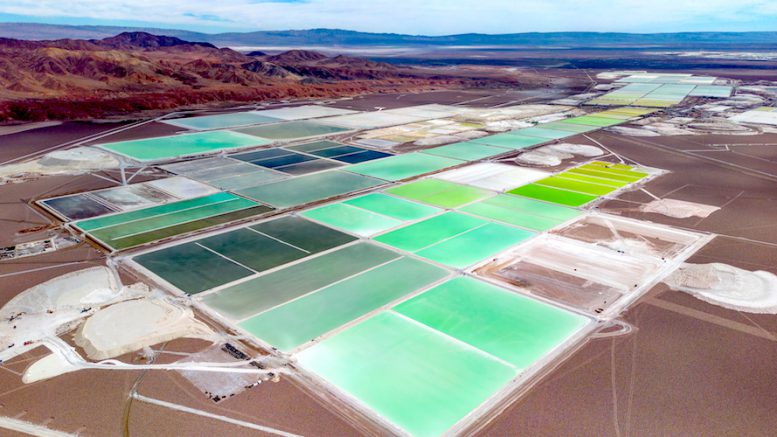Low lithium prices are forcing a raft of companies to delay spending on projects from Quebec to Nevada, from South America to Australia.
General Motors (NYSE: GM) has postponed a US$330-million investment in Lithium Americas’ (TSX: LAC; NYSE: LAC) Thacker Pass project in Nevada, large Chinese producer Ganfeng said investments must guarantee “significant near-term returns,” and Arcadium Lithium (NYSE: ALTM; ASX LTM) said it’s pausing its Galaxy project in Quebec. Albemarle (NYSE: ALB), the largest lithium producer, has slashed costs and delayed projects among its brine and hard-rock operations.
In August, Chile’s SQM (NYSE: SQM), the world’s second-biggest lithium producer, reported a 63% decline in quarterly profit. It forecasts low prices for the battery metal to persist for at least the rest of the year. In June, bond ratings company Fitch said lithium prices would remain below the peaks of 2022 and 2023 for at least five to 10 years.
“In spite of these cutbacks, most analysts expect the lithium market to remain subdued for the foreseeable future due to major stock overhangs and sluggish developed world electric vehicle sales,” BMO Capital Markets said in an Aug. 29 note.
The price of battery-grade lithium hydroxide has fallen to US$9,950 per tonne on Friday from US$22,275 a year ago and around US$85,000 a tonne in late 2022, according to The Wall St. Journal.
The tumbling price is driven by a rapid expansion of supply from African spodumene and Chinese lepidolite projects, BMO said.
Former James Bay
Arcadium says it wants a cost-sharing partner for Galaxy (the former James Bay project) and it’s delaying another venture in Argentina to save a total of US$500 million over two years.
In Australia, Core Lithium’s (ASX: CXO) CEO quit after it halted operations at its Finniss project in January due to the low prices. Pilbara Minerals (ASX: PLS) slowed production and curtailed some of its planned expansions.
Mineral Resources (ASX: MIN) is cutting production at the Mt Marion mine it runs with Ganfeng to 150,000 to 170,000 tonnes of spodumene this financial year from 218,000 tonnes last year. Underlying net profit after tax plunged 79% to A$158 million ($146 million) for the year ended June 30.
The price pressure extends to China, where this month battery producer Contemporary Amperex Technology (CATL) said it would suspend production at a mine that accounts for at least 5% of world supply.
Even so, Lithium Americas is trying to finalize a US$2.3-billion loan from the United States Department of Energy and several lithium companies are pressing ahead with projects as they eye long-term demand forecasts for the battery metal.
Project upswings
On Sept. 20, the U.S. Department of Energy said it’s considering as much as US$225 million, one of the largest ever U.S. grants for critical minerals, for the South West Arkansas project held by Standard Lithium (TSXV: SLI, NYSE: SLI) and Equinor (NYSE: EQNR).
That came a day after a key federal approval for Ioneer’s (ASX: INR) Rhyolite Ridge lithium mine in Nevada, which aims to produce enough metal to power nearly 370,000 electric vehicles a year.
Atlantic Lithium (AIM: ALL; ASX: A11) and Piedmont Lithium (NASDAQ: PLL; ASX: PLL) said they planned to start construction by year’s end at the Ewoyaa project in Ghana where Piedmont is covering 70% of the estimated US$185 million in development costs.
Australia’s Winsome Resources (ASX: WR1) said a new scoping study reinforces the economics of the US$260-million Adina project, which would use the former Renard diamond mine in Quebec to produce 282,000 tonnes a year of 5.5% spodumene concentrate. Also in Quebec, Patriot Battery Metals (ASX: PMT; TSX: PMET) is targeting initial lithium production capacity of 400,000 tonnes of spodumene concentrate at its Shaakichiuwaanaan project.
E3 Lithium (TSXV: ETL; US-OTC: EEMMF) is advancing its US$2.5-billion Clearwater brine project on one of Canada’s largest resources of the battery metal, in Alberta.
And AMG Critical Materials opened Europe’s first lithium hydroxide refinery in Germany which is targeting 20,000 tonnes of battery-grade lithium hydroxide a year – enough to power the batteries of around 500,000 EVs.
Assembly lines
Automakers themselves are dialing back output forecasts. Chrysler owner Stellantis said in August it was delaying plans to install an EV assembly line in a closed plant northwest of Chicago because of market conditions. That was even after Washington granted it US$335 million in July for the factory conversion.
Ford said it expected to incur a US$1.9-billion writedown for cancelling an electric SUV and delaying a pickup EV. Already it’s lost US$44,000 on each EV it sold during the second quarter and anticipates losing US$5 billion on them this year.
Consumers may be weighing the cost comparison to fuel a mid-sized car with electricity versus gasoline. An EV takes from US$12.61 to US$16.11 of voltage per 160 km compared with US$10.71 in gasoline, according to Anderson Economic Group. It says the difference is more for pickups.
Still, sales in EVs increased 23% globally in the year’s first half if measured in battery capacity instead of units, according to Toronto-based EV supply chain research firm Adamas Intelligence. The cost of battery materials going into an average EV has fallen by more than half since last year, it says.


Be the first to comment on "Lithium rout derails projects around the world, though some persist"